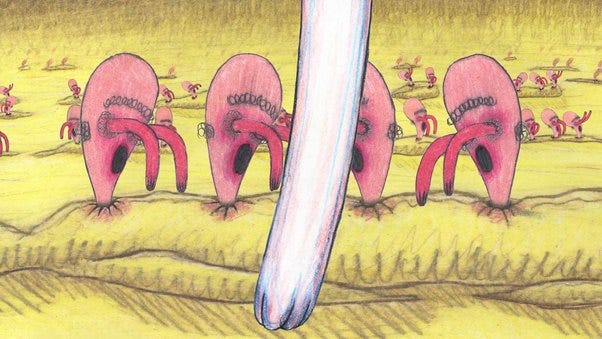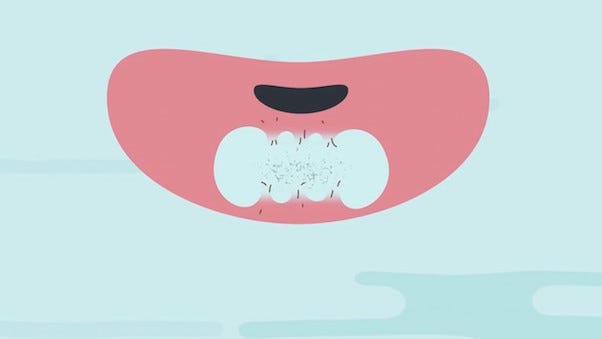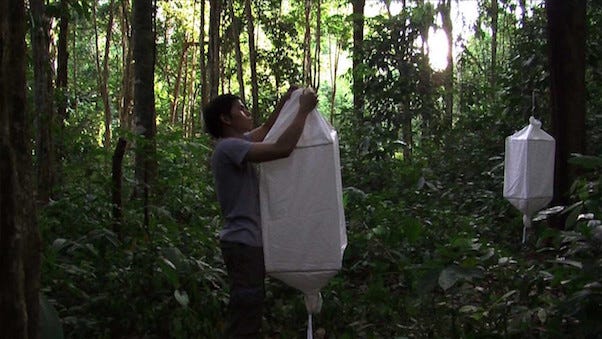This week, we look at how living systems store, retrieve and respond to essential information (CollegeBoard, 2016) in Part 3 of our education series.
While many high school science programs teach to the test, placing their focus on preparation for standardized exams, we propose a multi-disciplinary approach to education with a list of films to accompany biology curricula. The videos in this series have been selected with key lessons in mind. With films ranging from lab footage to experimental and documentary shorts, the package offers a range of entry-points for young learners to engage with the study of biology and develop critical thinking skills.

In this captivating short, director/producer Sonja Baeumel imagines “a world in which clothes could breathe, grow, and respond to the surrounding area.” The concept for this hypothetical membrane stems from research on “slime fungi,” which has a number of characteristics and capabilities that might be useful to humans.

“Amygdala is a scientific tale. Located deep inside the temporal lobe of the human brain, a small almond-shaped region orchestrates our emotional life. This is the amygdala, which is an ancient biology that deciphers whether an experience is emotionally traumatic or merely anxiety-ridden. It structures our emotional responses to these experiences. Amygdala is an experimental film that illustrates how the perception of fear operates by combining the lyrical tradition of a fairy tale with the vernacular nature of presenting scientific fact.”
-Jeannette Louie, writer/director/producer

Recent developments in the field of microbiology and synthetic biology expose facts from the “micro world” which previously were unknown. That means, following scientists from the University of Oregon and Human Microbiome Project, that each location in the world as well as each of us, can be identified by very unique microbial environments. The above mentioned research is still in the middle of development but since we managed to discover so much about the invisible environments of ours, what would it mean, in term of social behaviour and interaction in public spaces, if those technologies and data uncovered by it, become stored and commonly accessible… ? This short film speculates on the future of invisible, biological data of humans and spaces. Will anything change in our understanding of privacy in public space, when what is invisible becomes uncovered and starts to identify each of us?
The title takes its inspiration from the 19th century Parisian flaneur, often mentioned by Walter Benjamin or Baudelaire. A Flaneur is an urban explorer, who, by wandering around streets, discoverers new stories and affairs… BioFlaneur is the 2050 equivalent of the 19th century dandy. Instead of just walking around, the BioFlaneur uncovers modern stories and characters through simple bacteria sample scans, taken from the surface.
In this slightly absurd, exaggerated and imaginative way, this film aims to provoke a question about our awareness of personal, online privacy and its future, which together with new bio-technologies shares more and more facts from our life.”
-Aleks Cicha, writer/director/producer

In his animated short (which is featured in this month’s issue!), Matt Reynolds builds on biological concepts and imagery to create a surreal, microscopic world of bottom feeders.

“Exchange is a visual and informative illustration of air as the common bond between photosynthetic and respiratory organisms. The exchange of gases in the air — carbon dioxide for oxygen, and oxygen for carbon dioxide — between plants and animals is the most fundamental symbiosis on the planet."
-Danielle Parsons/Ravi Sheth, directors

By pairing high-contrast, flashing images with specific sound queues and music, Manfred Borsch “reflects the emotional processing of music in the limbic system and the resulting reactions of the body (the so-called “chills”). It has been proved that musical attributes like the violation of expectations, the beginning of something new, a new cue or a recurring pattern are more often leading to chills. Those can be expressed, among other things, through a higher heart rate, twitching facial muscles, sweaty hands or even the well-known goose bumps. The film discusses how far chill-experiences are part of the evolutionary and/or the cultural development.”
-Manfred Borsch

In their adorable short, Ramin Rahni and Sally Warring illustrate evolutionary biology at the cellular level and reveal key theories about cell interaction and human development over thousands of years.

“Biosemiotic Borneo – a more explicitly sonic than visual piece of art — lingers around a giant Banyan tree that stands in the Meratus Mountains in Southeast Borneo. Drawing attention to the semiotic processes of world-making in nature, the audio-visual work explores how artists and field biologists go about sensing and making sense of dense forest ecologies of Borneo using new methods that describe entire genetic assemblages as fluid text. The sensory richness of the forest inspired this piece to be a form of music in the way geophilosophy recasts natural selection as musical composition, which binds together the coevolution of a tree, birds, insects and symbiont microorganisms.”
-Ursula Riemann